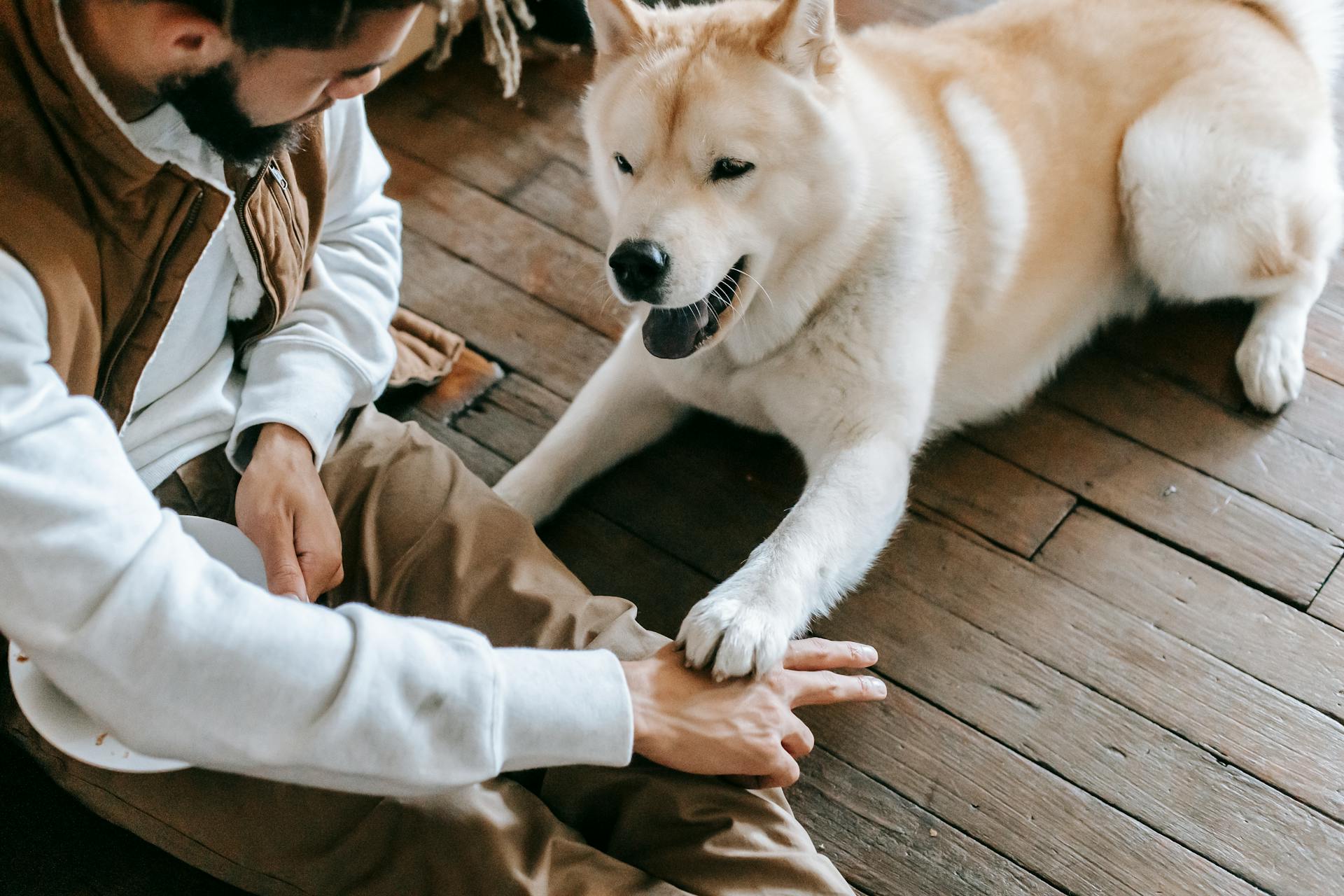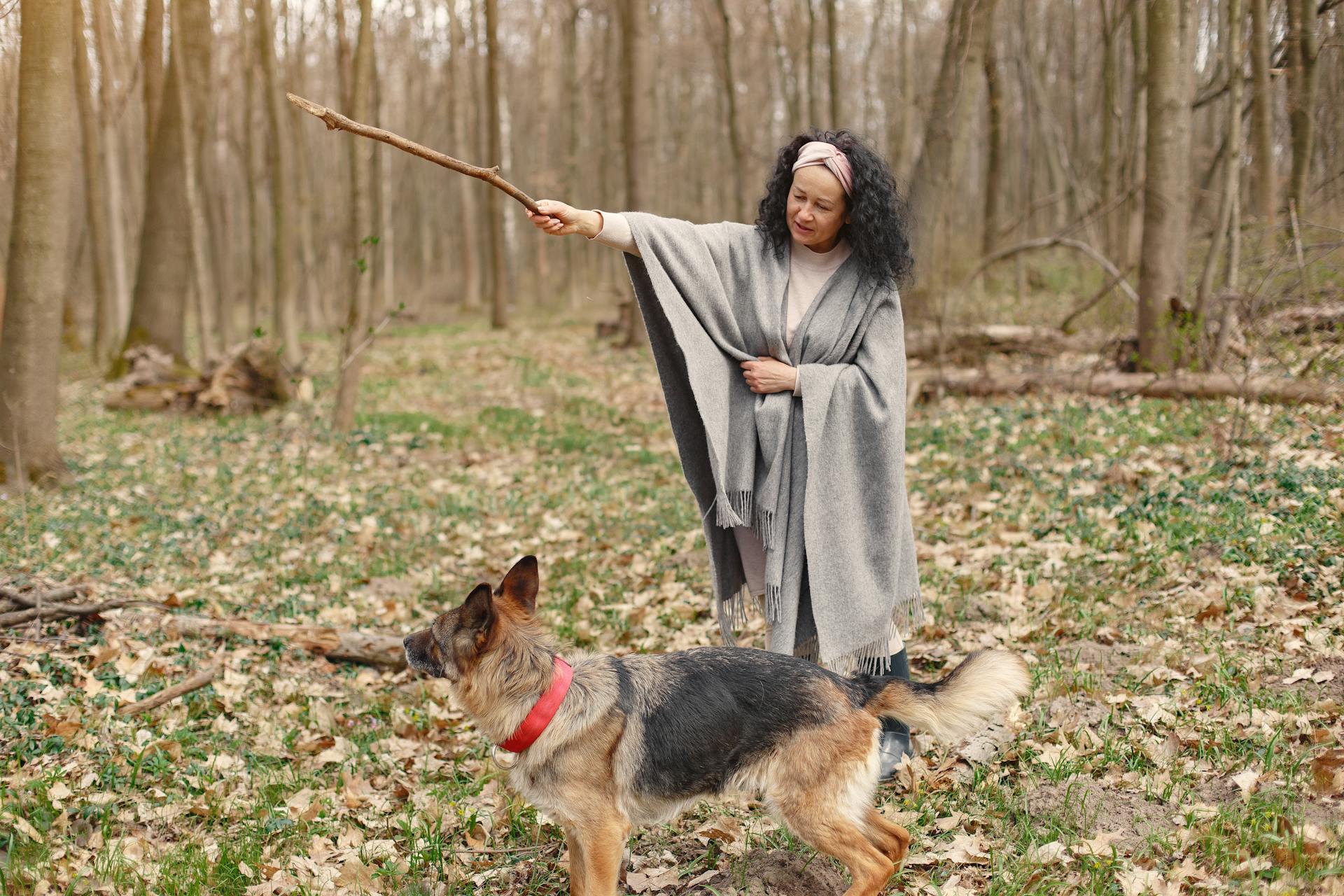
Training your dog not to jump can be a challenge, but it's a crucial part of responsible dog ownership.
Jumping is a natural behavior for dogs, but it can quickly become a nuisance if left unchecked. They jump up to greet people, to get attention, or to play.
To prevent jumping behavior, it's essential to understand the triggers that cause your dog to jump. One common trigger is excitement, as seen in many dog owners who inadvertently encourage their dogs to jump up by reacting to their enthusiasm.
By recognizing these triggers and taking steps to address them, you can train your dog to stop jumping and develop a more polite and respectful behavior.
Consider reading: It's Your Choice Dog Training
Why Do Dogs Jump?
Dogs jump for attention, it's a natural behavior for them to seek interaction with their pack, which includes their human family.
In fact, dogs are social animals that thrive on interaction and affection, and jumping is one way they get attention from their owners.
Dogs also jump to play, they have a strong instinct to engage in physical activity and have fun, which is why they often jump up to initiate play.
Some dogs jump due to excitement or anxiety, they might jump up and down when they see their owner come home or when they're in a new environment.
This behavior can be triggered by a variety of factors, including genetics, environment, and past experiences.
Dogs may also jump to protect their territory or resources, such as food or toys, which is a leftover from their wild ancestors.
In some cases, dogs jump due to medical issues, such as arthritis or hip dysplasia, which can cause them to move around awkwardly and jump up.
Regardless of the reason, it's essential to teach your dog that jumping up is not an acceptable behavior.
Take a look at this: Training Dog to Not Jump on Counter
How to Prevent
Preventing jumping is a crucial step in training your dog not to jump. You can't expect visitors to know or abide by your rules, so it's best to manage your dog's behavior before they even arrive.
To prevent jumping at the front door, try sending your dog to their mat or crate when the doorbell rings. You can also place a baby gate at the entranceway to block access. Keeping toys and treats at the front door can also help distract your dog and reward them for calm behavior.
Leashing your dog whenever guests arrive can also help prevent jumping. This way, you can maintain control and ensure your dog doesn't get too excited. By using these management techniques, you can prevent your dog from practicing jumping behavior.
Preventing jumping on strangers can be particularly challenging, but it's essential to avoid exposing your dog to situations where they might jump up. Instead, try to avoid having them greet strangers, and use a "watch me" cue or a squeaky toy to get their attention.
To prevent your dog from jumping on guests, use management techniques like leashing or blocking access to the front hall with a baby gate. You can also send your dog to their place, such as a mat or bed, to keep them occupied.
Capturing good behavior is key to preventing jumping. By having treats or toys ready in different locations, you can reward your dog for calm behavior and prevent them from jumping up. For example, you can toss a treat on the ground before your dog gets close enough to leap onto you, and then reward them for stopping to eat the treat.
If this caught your attention, see: Does Fixing a Female Dog Help with Aggression
Training Alternative Greetings
Teaching your dog an alternative greeting behavior is key to stopping the jumping. You need to tell them what to do, not just what not to do.
To start, choose a behavior that's incompatible with jumping, such as sitting or standing with all four paws on the floor. This will make it easier for your dog to learn.
According to experts, it's better to teach your dog what to do instead of jumping, rather than just trying to stop the jumping behavior. For example, "sit" for greetings is a simpler rule than "don't jump."
To make training easier, keep greetings low-key and calm. Dogs can sense our emotions, so if you're excited or riled up, they'll be too. Stay calm and quiet, even when praising your dog.
Here are some alternative behaviors you can teach your dog:
- Standing with all four paws on the floor
- Sitting
- Retrieving a toy
- Touch
- Going to a mat (or dog bed)
- Rollover to get a tummy rub
These behaviors are impossible to do at the same time as jumping, making them great alternatives. Remember to start teaching these behaviors when your dog is calm and not distracted.
To train your dog, use high-value treats and add in real-life rewards like eye contact, petting, and praise. This will help your dog understand what behavior gets your attention.
For example, if you want your dog to sit for greetings, start by training them to sit in a controlled environment, then gradually increase the distractions. Remember to be consistent and only greet your dog when they're following the new rule.
By teaching your dog an alternative greeting behavior, you'll be taking a huge step towards stopping the jumping. With patience, consistency, and positive reinforcement, you can help your dog learn a new way to greet people.
Take a look at this: Does Getting a Dog Fixed Help with Aggression
Managing the Environment
Managing the Environment is crucial in training your dog not to jump. By setting up the environment to your advantage, you can prevent unwanted behavior and encourage good habits.
You can start by putting your dog in their crate or confining them in another room before guests arrive, which will prevent jumping while they're learning proper behavior. This management technique can be especially helpful if your dog has a strong instinct to jump on visitors.
By blocking off areas where jumping happens the most, such as the front door or entryways, you can prevent your dog from practicing this behavior. This can be done using baby gates, free-standing gates, or exercise pens.
Overstimulated Puppy
Your puppy might be jumping up on you because they're overstimulated. All that energy has to go somewhere, might as well be up! Puppies tend to get overstimulated when they are hungry, tired, or there's a lot happening in their environment and they aren't sure what to do.
Jumping due to overstimulation is often combined with nipping, barking, or the "zoomies." I've noticed that my own puppy gets the zoomies when we have a lot of visitors at home. It's like they're trying to burn off all that excess energy.
Puppies might not know how to calm themselves down when they're overstimulated, which is why it's essential to provide them with a safe space to relax. A playpen or a crate can be a great place for them to hang out when they need some downtime.
You can use a playpen or a crate as a way to prevent unwanted behavior like jumping. Just make sure it's a comfortable and positive place for your puppy to be.
Broaden your view: Dog Place Mat Training
Managing the Environment

Managing the Environment is key to preventing your dog's jumping habit. It's essential to set up the environment to your advantage, as every successful jump on you becomes a habit.
To prevent jumping, manage your dog's behavior so they don't have the chance to practice jumping. For example, if your dog has a strong "go to your place" cue, you can send them to their mat or crate anytime the doorbell rings.
You can also place a baby gate at your entranceway to block your dog's access to visitors. Keeping toys and treats at the front door can help occupy your dog's time while your visitor enters. Alternatively, you can use a leash to keep your dog by your side.
Preventing jumping while walking your dog can be challenging, but it's not impossible. Try to avoid having your dog greet strangers, and instead, use a "watch me" cue or a squeaky toy to get their attention.
Additional reading: Dog Place Training Mat

Here are some management techniques to prevent jumping:
- Leashing your dog so they can't approach
- Sending your dog to their place, such as a mat or bed
- Using a baby gate to block the front hall
- Keeping your dog on a leash while walking
- Placing a gate or exercise pen to block off areas where jumping happens the most
These techniques will help you manage your dog's environment and prevent jumping, making it easier to teach them what to do instead of jumping.
Training Techniques
Training your dog not to jump is all about replacing unwanted behavior with something better. You can't just ignore your dog's jumping and expect it to stop, as they need to learn what to do instead.
One effective way to teach your dog an alternative greeting behavior is to ignore them when they jump and only give attention when they have all four paws on the floor. This means turning your back on them until they calm down.
You need to be consistent in your training program, so everyone in your family must follow the same rules. If your dog is allowed to jump on some people but not others, it can be confusing for them.
Preventing jumping from happening in the first place is key. You can do this by teaching your dog what to do instead of jumping, such as sitting or lying down.
Teaching your dog to sit is an easier rule than telling them not to jump. You can use a simple command like "sit" and reward them with treats when they do it correctly.
Here are some effective consequences to use when your dog does jump:
- Turn your back on them and ignore them until they calm down
- Give them a treat or praise when they have all four paws on the floor
- Redirect their attention to a different activity or toy
Remember, consistency is key when training your dog. Make sure everyone in your family is on the same page and following the same rules.
Frequently Asked Questions
Will my dog grow out of jumping up?
Most puppies tend to calm down and outgrow jumping up around 6 months of age, but this can depend on breed and individual personality. Proper socialization, especially with older dogs, can also help your pup learn to behave.
Do puppies grow out of jumping up?
Puppies typically outgrow jumping up around 6 months old, but this can vary depending on breed and individual personality. Proper socialization, especially with older dogs, can also help calm this behavior.
What is the best command to stop a dog from jumping up?
The "sit" command is the most effective way to stop a dog from jumping up on people. This simple command can help break a behavior that often starts in puppyhood when dogs receive attention for jumping.
How do you discipline a puppy from jumping and biting?
Discipline your puppy by ignoring one-off mistakes and immediately stopping play if biting or jumping persists. Turn away from your puppy for 10 seconds to communicate that biting stops the fun.
What is the dog command for no jumping?
The dog command for no jumping is "sit", as it's impossible to sit and jump at the same time. Using the "sit" command effectively stops dogs from jumping on people during walks.
Sources
- https://www.doggoneproblems.com/moody-stop-jumping-on-people/
- https://www.akc.org/expert-advice/training/how-to-stop-your-dog-from-jumping-up-on-people/
- https://www.humanesociety.org/resources/how-stop-your-dog-jumping
- https://www.akc.org/expert-advice/training/stop-dog-jumping/
- https://www.preventivevet.com/dogs/stop-your-dog-from-jumping
Featured Images: pexels.com


